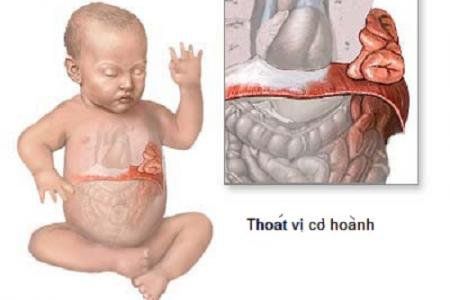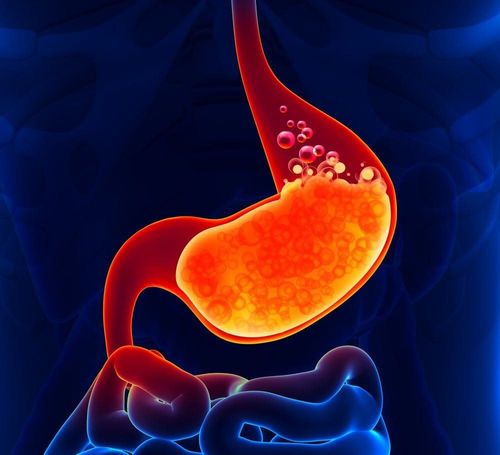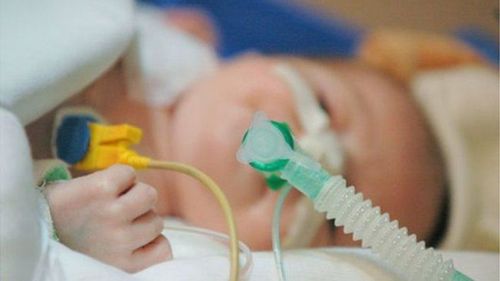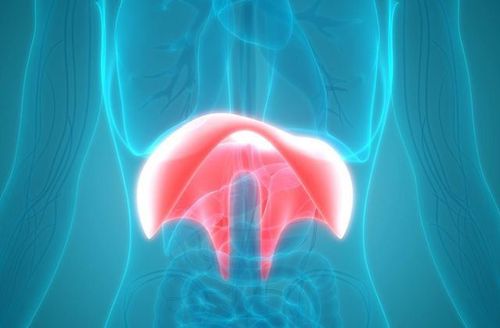This is an automatically translated article.
The article was consulted professionally with Master, Doctor Nguyen Thai Binh - Gastroenterologist - General Surgery Department - Vinmec Ha Long International General Hospital.Diaphragmatic hernia is a defect in the diaphragm that causes the abdominal organs to enter the thoracic cavity. Surgery is the only treatment; In which, laparoscopic surgery is preferred because of many advantages.
1. What is laparoscopic diaphragmatic hernia surgery?
The diaphragm is a thin layer of muscle that separates the chest and abdomen. A diaphragmatic hernia occurs when one or more abdominal organs move upward and into the thorax through any defect in the diaphragm surface. In children, this defect can occur from birth, called a congenital diaphragmatic hernia. In adults, diaphragmatic hernia is often acquired after trauma or an accident. However, regardless of the cause, if the diaphragmatic hernia occurs acutely, the abdominal organs compress the heart and lungs, affecting breathing, all need emergency surgery to ensure life. In contrast, if the hernia is small and not stuck, the patient can be scheduled for intervention according to the program.
Currently, there are two surgical methods to treat diaphragmatic hernia: open surgery and laparoscopic surgery. Both approaches have the same principle of rearranging organs from the thorax and back into the abdomen and then repairing the diaphragm, restoring continuity of integrity. However, if it is not an emergency situation, laparoscopic surgery is preferred today due to many advantages.
For laparoscopic surgery, the patient is minimally invasive through very small holes in the skin, inserting small, thin and flexible tubes, inside the tube containing the camera as well as interventional instruments into the cage. chest and abdomen. The image captured on the camera will be projected onto the screen, instructing doctors to control the instrument inside the patient's body. The outstanding advantage of this method is that it achieves high aesthetics with very small scars, while open surgery has a large area of intervention, requires a long recovery time, and risks bad scarring. However, centers that want to be able to perform laparoscopic surgery to repair the diaphragm require a system of machines, equipment according to the requirements of endoscopic techniques, well-trained and experienced surgeons. to reduce the risk of recurrence.

2. Pre-surgery preparation steps
Unless traumatic diaphragmatic hernias require emergency surgery, the success rate of diaphragmatic repair will depend on prior preparation.
Accordingly, before deciding to have surgery, the patient needs to confirm the diagnosis of diaphragmatic hernia through clinical examination and signs on imaging such as ultrasound, x-ray, computed tomography. In addition, it is necessary to ensure that the patient is able to tolerate anesthesia and surgery, and does not have serious, terminal or malignancies. In addition, the physician must rule out contraindications to general surgical intervention such as coagulopathy, local infection of the abdomino-thoracic wall, or contraindications to laparoscopic surgery such as the need for peritoneal inflation such as: patients with cardiovascular disease, chronic lung disease... coronary, valvular heart disease, chronic cardiopulmonary disease.
Next, the patient will have a pre-operative examination and perform general basic tests. In addition, upper gastrointestinal endoscopy may also be necessary, helping the surgeon to pre-evaluate the type of malformation of the diaphragm. At the same time, the patient was also instructed on body hygiene, fasting, rehydration of water and electrolytes, prophylactic antibiotic infusion, sedation, and anesthesia right before the surgery.
3. How is laparoscopic surgery for diaphragmatic hernia performed?
On the operating table, the patient is arranged to lie on his back with the head high, legs low, an angle of 30 degrees different from the horizontal plane; straightened limbs. In addition, the patient was also placed a nasogastric tube, urinary catheter and endotracheal ventilation.
Then, when the whole process is stabilized, the surgeon will conduct the surgery by putting the camera into view and inflating. Next, repair of the diaphragm will be done in three consecutive steps:
3.1. Restructuring the position of the organs Bring the herniated parts of the viscera into the thorax back into the abdomen. The organs commonly herniated are hollow viscera with high displacement such as the cardia of the stomach, the loops of the small intestine or the colon. If the hernia hole is narrow or there is adhesion of viscera to adjacent organs, it should be carefully dissected to avoid further trauma, perforation. 3.2. Diaphragm repair If the hernia hole is small, close the mouth and close the hernia permanently. If the hernia is large, consider using a graft to cover the hernia. 3.3. Examination of the abdomen and termination It is necessary to investigate the continuity of the abdominal viscera and the diaphragmatic surface to avoid hernia recurrence or hernia in another location. Finally, check the sacral fluid and natural grooves in the abdomen before withdrawing the trocar and closing the abdominal wall.
4. What to monitor after surgery?
The things to monitor in patients after laparoscopic surgery for diaphragmatic hernia are similar to those of general abdominal surgery. In particular, the most important is the nursing work when recovering, taking care of the incision as well as guiding the patient to eat again by mouth.
In addition, it is necessary to continue antibiotics for 5 to 7 days because this is an infection surgery, there is a high risk of peritonitis. Simultaneously, monitor respiratory function, cardiovascular function, intestinal motility, body temperature daily after surgery.

5. Complications and how to manage
5.1. Complications occur during surgery Trauma causes perforation of organs such as diaphragm and adjacent organs during the procedure such as esophageal perforation, gastric perforation, intestinal perforation: immediate suture, drainage of secretions . Bleeding due to vascular trauma: clamp hemostasis clip for large vessels, electrocautery for small vessels. 5.2. Complications occurring after surgery Intra-abdominal bleeding: open abdominal wall for re-exploration and hemostasis abdominal cavity and drainage in combination with broad-spectrum systemic antibiotics. Pneumothorax, pneumomediastinum: mechanical ventilation, drainage or thoracic surgery Recurrent diaphragmatic hernia: incidence is 5 to 20% and up to about 30% for hernia closure cases with using artificial grafts. When a patient has signs of diaphragmatic dysfunction, it is best to seek medical attention early to avoid serious complications.
In summary, laparoscopic surgery for diaphragmatic hernia is a relatively complicated technique, with a high risk of recurrence as well as dangerous complications. To improve efficiency, it is necessary to choose a reliable center with a team of qualified and experienced doctors as well as fully equipped with necessary equipment and facilities. Vinmec International General Hospital has good experts and the most modern equipment. Please contact us for the most timely advice, examination and treatment to avoid affecting your health.
Please dial HOTLINE for more information or register for an appointment HERE. Download MyVinmec app to make appointments faster and to manage your bookings easily.














